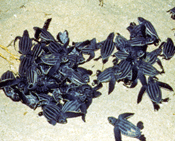| 
Teresa
Tallevast
Refuge Manager
P.O. Box
190
Culebra,
PR 00622
(787) 742-0115
FAX: (787) 742-0115
E-mail: caribbeanisland@fws.gov
 Directions
to Refuge Directions
to Refuge
 Fact
Sheet Fact
Sheet


|
|
 Refuge
Facts Refuge
Facts
- Established: 1909.
- Acres: 1,568.
- Location: the refuge office
is located in Lower Camp, a short drive from Culebra airport.
- Administered under Caribbean
Island NWRs office.
Natural History
- The refuge is comprised
of lands on the main island of Culebra and 22 smaller islands in the
same vicinity.
- The refuge contains diverse
habitats including subtropical dry forest, mangroves, brush, and grasslands.
- The largest seabird nesting
colony occurs at Peninsula Flamenco, where 60,000 sooty terns nest.
- Mount Resaca contains the
largest remaining forest, an area of rock-strewn canyons and ravines
forming a unique habitat known as the boulder forest.
- Leatherback and hawksbill
sea turtles use refuge beaches for nesting.
Financial Impact of Refuge
- Two-person staff.
- 6,000 visitors annually.
Refuge Objectives
To protect and manage
significant seabird colonies and endangered marine turtles, as well as
protect native tropical vegetative communities.
Management Tools
- Environmental education/
interpretation.
- Law enforcement.
- Wildlife surveys.
Public Use Opportunities
- Hiking, wildlife observation,
and nature photography are available (boat access only) on Cayo Luis
Pena and Isla Culebrita.
- All other refuge lands are
closed to the public because of their sensitive nature or unexploded
military ordnance.
Calendar of Events
October: National
Wildlife Refuge Week. Questions
and Answers
Does the refuge have an
office for visitors?
An office is located
in Lower Camp, a short drive from Culebra airport.
Are sea turtles found in the
vicinity of the refuge?
Yes, leatherback and hawksbill sea turtles nest on Culebra
beaches, and the adjacent seagrass beds provide shelter and food for green
sea turtles.
Is it true that seabirds nest on the refuge in large numbers?
A nesting colony of approximately 60,000 sooty terns is located
at the Peninsula Flamenco unit; however, it is closed to the public due
to its sensitive nature.
|






